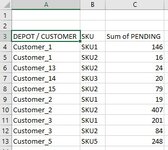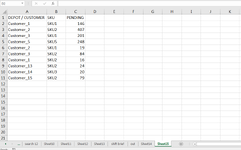I have a data which contains 18 columns, I need to summarize the data based on the 1st 2 columns and in the summary there will be just 3 columns as shown in below table
Raw Data in Sheet1
Need Summary in Sheet 2 as follows with these 3 columns (1st 2 columns and Sum of Column "Pending")
Raw Data in Sheet1
| DEPOT / CUSTOMER | SKU | DESCRIPTION | BUSINESS LINE | PRIMARY UOM | SECONDARY UOM | UNIT VOLUME | C1 (Y/N) | SO | RQ | ISO | ISO DATE | DLV | ORDERED | SHIPPED | PENDING | PICKED | WEIGHT |
| Customer_1 | SKU1 | Product 1 | Business1 | E | L | 5 | YES | 149876 | 3764816 | 3542954 | 09-Nov-22 | 37627225 | 110 | 28 | 82 | 0 | 0 |
| Customer_2 | SKU2 | Product 2 | Business2 | E | L | 1 | NO | 3575499 | 3370748 | 06-Jun-22 | 37627226 | 684 | 516 | 168 | 0 | 0 | |
| Customer_3 | SKU1 | Product 3 | Business3 | E | L | 2 | YES | 205575 | 3500505 | 3301785 | 05-Apr-22 | 37627227 | 1500 | 1320 | 180 | 0 | 0 |
| Customer_1 | SKU1 | Product 4 | Business4 | E | L | 2 | YES | 205575 | 3500507 | 3301787 | 05-Apr-22 | 37627228 | 1500 | 1468 | 32 | 0 | 0 |
| Customer_5 | SKU5 | Product 5 | Business5 | E | L | 2 | YES | 205575 | 3566757 | 3362678 | 30-May-22 | 37627229 | 600 | 352 | 248 | 0 | 0 |
| Customer_3 | SKU1 | Product 6 | Business6 | E | L | 10 | YES | 83586 | 3528928 | 3327850 | 28-Apr-22 | 37627230 | 1182 | 1161 | 21 | 0 | 0 |
| Customer_1 | SKU1 | Product 7 | Business7 | E | L | 4 | YES | 190970 | 3534232 | 3332754 | 02-May-22 | 37627231 | 152 | 120 | 32 | 0 | 0 |
| Customer_2 | SKU1 | Product 8 | Business8 | E | L | 18 | YES | 80458 | 3535595 | 3334065 | 03-May-22 | 37627232 | 950 | 931 | 19 | 0 | 0 |
| Customer_3 | SKU2 | Product 9 | Business9 | E | L | 1 | NO | 3544187 | 3341957 | 10-May-22 | 37627233 | 1800 | 1716 | 84 | 0 | 0 | |
| Customer_1 | SKU2 | Product 10 | Business10 | E | L | 16 | YES | 131602 | 3516206 | 3316242 | 18-Apr-22 | 37627234 | 100 | 84 | 16 | 0 | 0 |
| Customer_2 | SKU2 | Product 11 | Business11 | E | L | 10 | YES | 78372 | 3539301 | 3337438 | 06-May-22 | 37627235 | 1400 | 1365 | 35 | 0 | 0 |
| Customer_2 | SKU2 | Product 12 | Business12 | E | L | 1 | NO | 3545288 | 3342976 | 11-May-22 | 37627236 | 828 | 624 | 204 | 0 | 0 | |
| Customer_13 | SKU2 | Product 13 | Business13 | E | L | 10 | NO | 3545293 | 3342980 | 11-May-22 | 37627237 | 96 | 72 | 24 | 0 | 0 | |
| Customer_14 | SKU3 | Product 14 | Business14 | E | L | 20 | NO | 3597923 | 3391123 | 25-Jun-22 | 37627238 | 270 | 250 | 20 | 0 | 0 | |
| Customer_15 | SKU2 | Product 15 | Business15 | E | L | 14 | NO | 3611702 | 3403929 | 06-Jul-22 | 37627239 | 150 | 71 | 79 | 0 | 0 | |
Need Summary in Sheet 2 as follows with these 3 columns (1st 2 columns and Sum of Column "Pending")
| DEPOT / CUSTOMER | SKU | PENDING |
| Customer_1 | SKU1 | 146 |
| Customer_1 | SKU2 | 16 |
| Customer_13 | SKU2 | 24 |
| Customer_14 | SKU3 | 20 |
| Customer_15 | SKU2 | 79 |
| Customer_2 | SKU1 | 19 |
| Customer_2 | SKU2 | 407 |
| Customer_3 | SKU1 | 201 |
| Customer_3 | SKU2 | 84 |
| Customer_5 | SKU5 | 248 |








